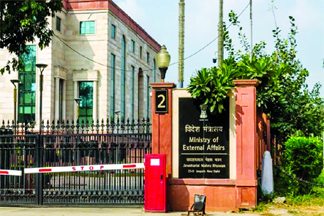

“If Air India, nationalized in the 1950s, is now privatized, we would have come full circle. However, its case is more symbolic than substantive. Today there is no dearth of air-travel service providers in India, and the public airline reportedly has less than 15% market share. This is not the case in some other areas of the economy where public provision is fundamental. Take rail travel, which has no substitute. For it to serve its public purpose, the financial health of the Indian Railways is vital”.
Having announced its decision to sell Air India, the government is making arrangements to do so. The move itself has come after multiple efforts by successive governments to resurrect the national airline. Though there has been news of it finally turning in an operating profit under a determined CEO, its debt, reportedly a staggering $8.5 billion, must weigh on the minds of a public drawn into a discussion of its future.
The beginnings
It is unfortunate that so iconic an entity, once feistily steered by J.R.D. Tata, has met this fate, but it is not uncommon in the history of India’s public sector. To understand this ending, we would have to start at the beginning, and that was with the transformation of the economy attempted in the 1950s. While there were monumental gaps in that attempt, there were also creative innovations, the most important being the public sector. By design, the public sector was to exist along with a private one resulting in what had been referred to as ‘the mixed economy’. To those hankering after institutional purity this was no more than a joke, an arrangement that had strengths of neither full-bodied American-style capitalism nor of out-and-out Soviet-era communism. Half a century later, the Soviet empire imploded and for a brief moment in 2008, the American one teetered on the brink, having been taken there by its vanguard, finance capital. We can now see that the mixed economy, combining the public and private sectors, is superior to one located at either extreme.
So, if the public sector is a force for the good, why is it that we see Air India, and a section of the rest of the Indian public sector, in so unsound a financial condition? In its early days, the public sector had been quite healthy. This need hardly come as a surprise when we recognize the then Indian leadership’s motive for building one. Stripped of its somewhat ideological construction as straddling ‘the commanding heights’ of the economy, it was to have a central role in the quickening of the economy after 1947. Wrecked by two centuries of colonialism, India’s economy was moribund. The post-colonial Indian leadership had envisaged the public sector as the ship that would steer the economy out of the morass. And they were not wrong.
Under Nehru, India’s economy rose spectacularly, and public investment was the principal engine of growth in that remarkable phase. Used as we are to Air India having to, at times, borrow even to finance its working capital, it may come as a surprise to know that it was still making profit into the second half of the 1960s. As for the public sector as a whole, during the Nehru era its savings had grown faster than that of the private corporate sector. Actually, to an extent India’s public sector had financed itself.
Nehru’s speech at the inauguration of the second plant of the Hindustan Machine Tools (HMT) in Bangalore in 1962 is instructive in this regard. He congratulated the workers of HMT for having produced a second plant entirely out of the surplus of the first one. In one stroke, this conveys the rationale imagined for India’s public sector at the moment of its conception. It had been imagined as a source of investible funds for the public purpose. Underlying this was the belief that the private sector may not generate the necessary surplus, especially if the economy was not first quickened through public investment.
It is noteworthy that in the heyday of the public sector, India’s private corporate sector had not done badly at all. Its investment rose at least much as that of the public, demonstrating that claims of its suppression due to the license-permit raj are exaggerated. It is true that some entities had been excluded by licensing. Licensing was necessary to ensure that resources were used in accordance with the plan for industrialization, but it was the case that private firms receiving licenses benefited greatly from the expansion of the market resulting from public investment. It is perhaps not known widely enough that in the Nehru era India grew faster than China.
What went wrong?
So, if the public sector had such a central role in lifting India out of a morass, why are we where we are today? Why is Air India awaiting the gavel? This has entirely to do with politics. Politics underwent a sea change in the second half of the 1960s and with this the de facto status of the public sector was to change. It became the handmaiden of Indira Gandhi’s attempt to gain absolute control. Performance no longer counted, and the public sector was now validated by its very existence. Intimation of the changed policy stance appears in the form of an entry in an ‘Economic Survey’ from the 1980s emphasizing that a large section of employees of the public sector were those absorbed from loss-making units. This was to be a point of no return as the public sector was no longer treated as the fulcrum of the economy but as a political instrument. It was not as if some successes, such as of Maruti Udyog, were not to come yet but the original sense of purpose was lost.
If Air India, nationalized in the 1950s, is now privatized, we would have come full circle. However, its case is more symbolic than substantive. Today there is no dearth of air-travel service providers in India, and the public airline reportedly has less than 15% market share. This is not the case in some other areas of the economy where public provision is fundamental. Take rail travel, which has no substitute. For it to serve its public purpose, the financial health of the Indian Railways is vital.
We have reason to believe that this is threatened. The present Minister for Railways has announced that the decay of the capital stock has contributed to reduced safety. In particular that the recent spate of derailments has to do with inadequate signaling equipment and damaged tracks. Scarcity of funds for proper maintenance of the capital stock is directly related to populism. The replacement in 2012 by his party supremo Mamata Banerjee of a Railways Minister who had raised passenger fares demonstrates the role of politics in running India’s public sector into the ground. Unlike the airlines, the railways are a life-line for a large number of Indians, and maintaining their good health is vital to their interest. It is naïve to imagine that the public sector can remain immune to inflation in the economy.
Meanwhile, an effort to turn around the public sector has come from an unlikely section. The Communists of Kerala, prone to rationalizing inefficiency when it suits their politics, have now embarked upon a revival of the State’s public sector undertakings. This has met with success in a short time, with at least some loss-making units turning profitable. The parlous state of public finances may have forced this political party’s hand but the move itself shows maturity. Hopefully it will serve as a model for the rest of the country. The public sector would be a jewel when worn in the public interest. When it is not, as was the case with Air India, it turns into a millstone around our necks.
(The author is Professor of Economics of Ashoka University and Senior Fellow of the IIM Kozhikode)





Be the first to comment